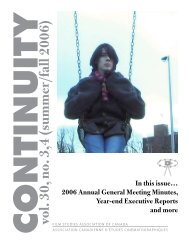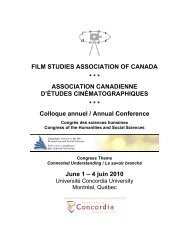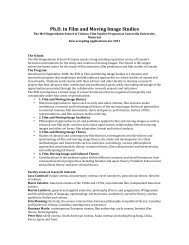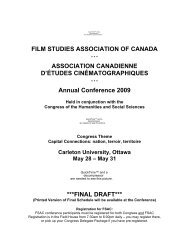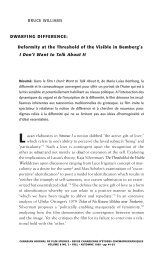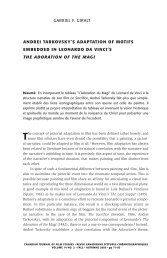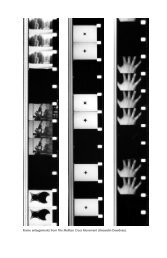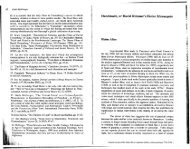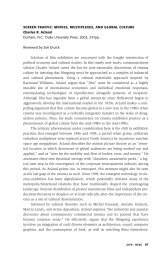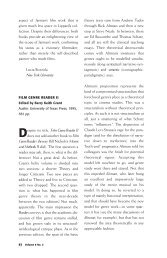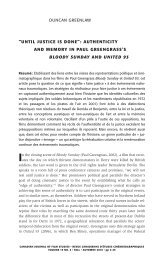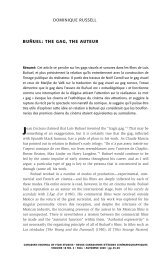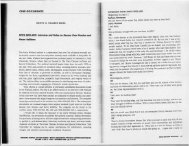cinematic experience, film space, and the child's world - Film Studies
cinematic experience, film space, and the child's world - Film Studies
cinematic experience, film space, and the child's world - Film Studies
You also want an ePaper? Increase the reach of your titles
YUMPU automatically turns print PDFs into web optimized ePapers that Google loves.
005.Kuhn.19.2:005.Kuhn. 11/18/10 5:32 PM Page 95<br />
route from one place to ano<strong>the</strong>r. However, in scenes towards <strong>the</strong> end of <strong>the</strong> <strong>film</strong>,<br />
<strong>the</strong> canal does begin to take on some qualities of a place of passage—albeit an<br />
uncertain kind of passage—between “home” <strong>and</strong> Margaret-Anne’s flat. The passage<br />
is dis-located <strong>and</strong> un-placed, in that <strong>the</strong> beginning <strong>and</strong> end points of<br />
James’s journeys between <strong>the</strong> one <strong>and</strong> <strong>the</strong> o<strong>the</strong>r are not spatially tied in. The<br />
canal is distinctive, too, in that it morphs from being tightly, almost claustrophobically,<br />
framed at <strong>the</strong> start to figuring in an increasingly extensive spatial<br />
context as <strong>the</strong> <strong>film</strong> progresses, until at <strong>the</strong> end it is seen in a wide, extreme long<br />
shot that shows a broad expanse of waste ground edged in <strong>the</strong> far distance by<br />
high-rise flats <strong>and</strong> o<strong>the</strong>r buildings.<br />
The new house <strong>and</strong> its adjoining field appear on three occasions in <strong>the</strong><br />
course of <strong>the</strong> <strong>film</strong>, <strong>the</strong> first in a lengthy sequence that opens with James sitting<br />
on a step at <strong>the</strong> threshold of <strong>the</strong> Gillespies’ tenement close watching his older<br />
sister as she crosses <strong>the</strong> road to wait at a bus stop. In a bid to discover her mysterious<br />
destination, James goes back into his flat <strong>and</strong> filches some coins from his<br />
fa<strong>the</strong>r’s trousers pocket. He returns to <strong>the</strong> street <strong>and</strong> boards <strong>the</strong> bus. In exp<strong>and</strong>ed<br />
time, <strong>the</strong> bus conveys him from his street out to <strong>the</strong> terminus, apparently far<br />
into <strong>the</strong> countryside. Here James comes upon an estate of partially-built houses,<br />
enters one, <strong>and</strong> explores <strong>the</strong> white <strong>space</strong>s inside, eventually discovering an<br />
unglazed window <strong>space</strong> beyond which a golden, empty field is visible. He clambers<br />
out <strong>and</strong> runs <strong>and</strong> plays in <strong>the</strong> field; <strong>and</strong> is <strong>the</strong>n next seen walking back<br />
home along an empty road.<br />
Throughout this sequence, <strong>the</strong> various <strong>space</strong>s (close, street, “home,” new<br />
house) are tied toge<strong>the</strong>r, ei<strong>the</strong>r by spatiotemporal editing <strong>and</strong>/or by point-of-view<br />
shots. The whole passage is exactly a journey from home to an unfamiliar <strong>space</strong><br />
<strong>and</strong> <strong>the</strong>n back home again, much as described by Balint in his discussion of<br />
“home” <strong>and</strong> “friendly expanses.” The thresholds <strong>and</strong> <strong>the</strong> intermediate <strong>space</strong>s are<br />
clear, <strong>and</strong> <strong>the</strong> unfamiliar <strong>space</strong>s of <strong>the</strong> new house <strong>and</strong> field possess <strong>the</strong> qualities<br />
of Balint’s “friendly expanses” <strong>and</strong> of <strong>the</strong> real/imaginal <strong>space</strong> of playing. The bus<br />
journey is <strong>the</strong> <strong>film</strong>’s only instance of locomotion o<strong>the</strong>r than on foot. In relation<br />
to <strong>the</strong> defining characteristics of children’s geographies, <strong>the</strong> bus journey—along<br />
with <strong>the</strong> temporal expansiveness of James’s journey—marks <strong>the</strong> <strong>space</strong> of <strong>the</strong><br />
new house as “o<strong>the</strong>r” in terms of <strong>the</strong> child’s <strong>world</strong>. In this way, too, <strong>the</strong> new<br />
house is set up as both real <strong>and</strong> imaginary. In every one of <strong>the</strong>se respects, this<br />
sequence is in clear contrast to all of <strong>the</strong> canal scenes. It is also markedly different<br />
from <strong>the</strong> subsequent two occasions on which <strong>the</strong> new house is seen. 27<br />
* * *<br />
The metapsychological argument about <strong>film</strong> <strong>and</strong> cinema advanced here is that<br />
through its organization within <strong>the</strong> frame of spatiality, liminality <strong>and</strong> motion, <strong>the</strong><br />
medium is capable of replaying or invoking states of being that are commonly<br />
<strong>experience</strong>d as inner, <strong>and</strong> which operate largely at a preconscious, ra<strong>the</strong>r than at<br />
CINEMATIC EXPERIENCE, FILM SPACE, AND THE CHILD’S WORLD 95



